The art world is, it’s fair to say, increasingly preoccupied with craft. From Anni Albers’ exhibition of weaving at Tate Modern to ‘The most real thing: contemporary textiles and sculpture’ at the New Art Centre in Salisbury, exhibitions that reflect this interest are on the rise. As such, the Barbican’s latest commission for The Curve is a canny choice. New Zealand-born artist Francis Upritchard is renowned for drawing from craft traditions, and her installation ‘Wetwang Slack’ is no exception. Contrasting with the building’s Brutalist architecture, Upritchard has filled the curving space with dozens of handmade objects in a rainbow palette of hues.
Visitors are met by a procession of figures sculpted in polymer clay and clad in colourful textiles. There’s a blue-skinned man with three arms and four legs, and figures of uncertain gender and ethnicity bedecked in ornamented tunics. It’s a cross-cultural smorgasbord of hippyish characters; one, titled New Life (2018), wears a badge on its mustard-coloured garments that reads ‘The Museum of Cosmic Consciousness, Fenberger House Visitor’. Some sneer cynically, others smile beatifically – it’s unclear if this is celebration or satire. Paul Thek’s sculptural effigy The Tomb – Death of a Hippie (1967) is a clear precedent, but the tragicomic tone of Thek’s death-knell for counterculture is missing in Upritchard’s more decorative works.
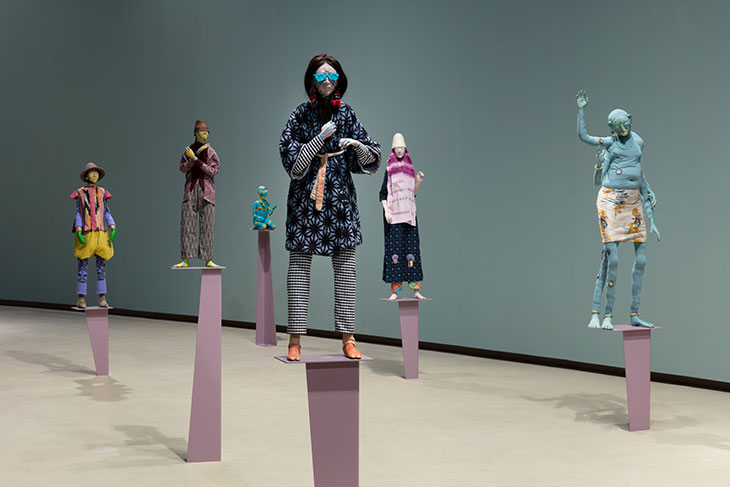
Installation view of ‘Wetwang Slack’, Barbican Centre, London, 2018. Photo: Angus Mill
The influence of Thek continues with a parade of deformed, brown-toned hands and fingers akin to his grisly wax sculptures of body parts. Laid out on a table like archaeological finds, Upritchard’s are reminiscent of ancient remains discovered in peat bogs or the relics of saints. Nearby is a wall-mounted glass cabinet that recalls a musty museum display. Rather than faded fragments, however, it is filled with cod-historical bangles, chalices and absurd opaque sunglasses, all rendered in neon polymer clay. Next comes shelving filled with undersized hats and some vitrines filled with wobbly glassware – tangerine-coloured bottles painted with sea life and centaurs, which recall Graeco-Roman finds – and pots that borrow from various ceramic traditions. Tall Brown Urn (2018) is reminiscent of 16th-century German salt-glaze Bartmann jugs, for instance, while Tenmoku Jar (2018) uses a glaze key to the Japanese pottery tradition. These would be serious pots, if it weren’t for the incised and modelled face on each. It’s like visiting the British Museum on acid: both hallucinatory and museological.
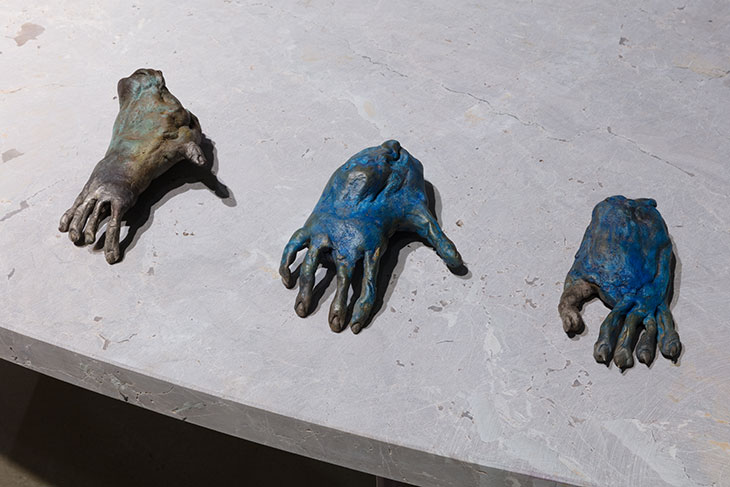
Installation view of ‘Wetwang Slack’, Barbican Centre, London, 2018. Photo: Angus Mill
That the installation’s name is borrowed from an archaeological site in Yorkshire indicates Upritchard’s fascination with how societies explore their histories. But if there’s a response here to our relationship with artefacts, it’s little more than a playful, David Shrigley-esque smile. Unlike Upritchard’s early grotesque sculptures of the shrunken heads of white colonials, which through an antagonistic reversal of roles contributed to debates around the return of Māori preserved heads (mokomokai) to New Zealand, there’s nothing critical to be found.
Instead, ‘Wetwang Slack’ feels like a joyful celebration of the comparatively non-hierarchical nature of craft, open to experts and have-a-go hobbyists alike. Take for instance Upritchard’s choice of polymer clay, which she sculpts over wire armatures and then paints. They are skilfully modelled, bearing realistic details such as lined eyes and chipped nails. However, the material is one scorned by professional ceramic artists – it is in fact a plastic, and contains no clay at all. There’s a gleefully liberal use of appliquéd patches with diamanté eyes, the Do-It-Yourself ornaments covering clothing and hats alike. A cushion-strewn nook titled Cosy Spot (2018) features naïve watercolours of motifs seen elsewhere. Wobbly yet confident, they resemble the offerings of a proud amateur. But if Upritchard here is aiming to blur the lines between contemporary art and craft, then why is no acknowledgement made, in the exhibition texts, of her collaborations with craftspeople? These skilled fabricators include the furniture designer (and Upritchard’s husband) Martino Gamper, responsible for the shelving and plinths, and glassmaker Jochen Holz.
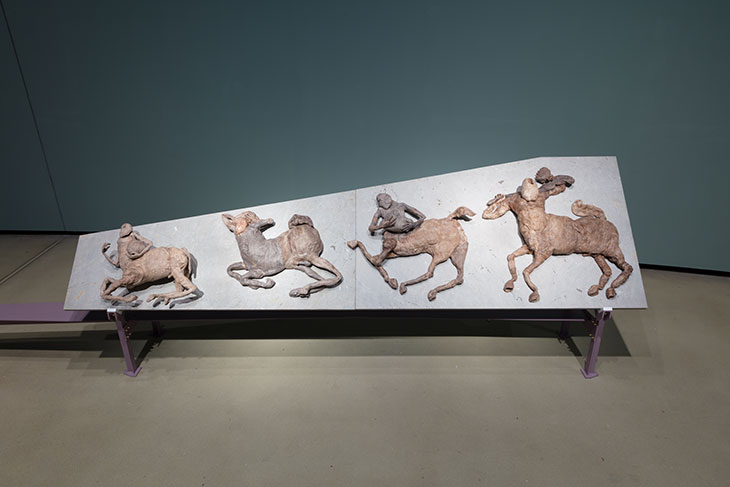
Installation view of ‘Wetwang Slack’, Barbican Centre, London, 2018. Photo: Angus Mill
The exception is Darlindo José de Oliveira Pinto, the master of balata (Brazilian wild rubber) who taught Upritchard his craft. Upritchard uses the skin-like material for relief sculptures of centaurs inspired by the Parthenon friezes, and impressive free-standing sculptures of the Japanese folklore characters Ashinaga-tenaga. Of this pair, the myth goes, one had very long legs and the other long arms: with teamwork, they were able to thrive. Theirs is a story celebrating mutually beneficial working relationships. It’s not too far a stretch to say there’s a similarly rewarding exchange taking place between the worlds of contemporary art and craft. In the future, let’s hope we’ll get see the exchange explored even further.
‘Francis Upritchard: Wetwang Slack’ is at The Curve, Barbican Centre, London, until 6 January 2019.
Unlimited access from just $16 every 3 months
Subscribe to get unlimited and exclusive access to the top art stories, interviews and exhibition reviews.

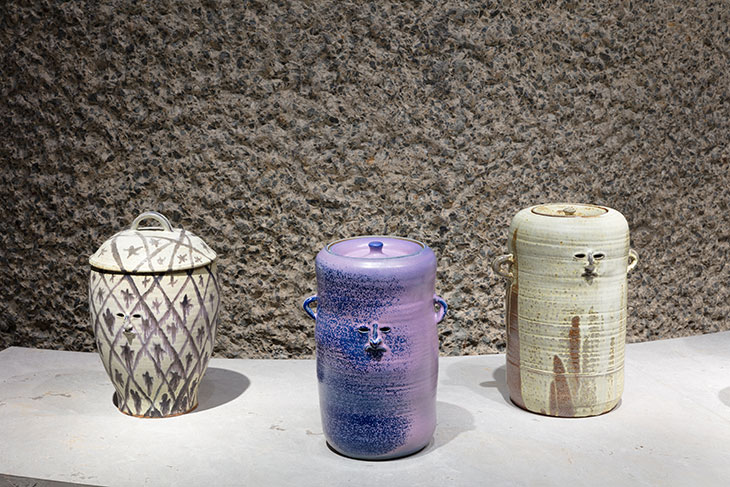
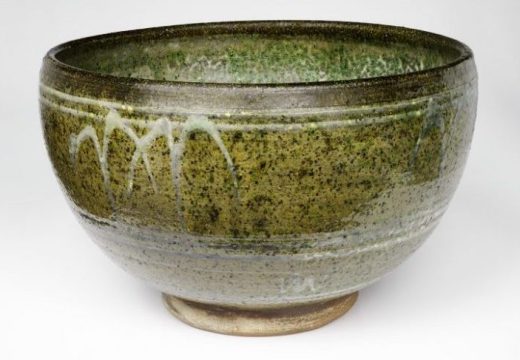
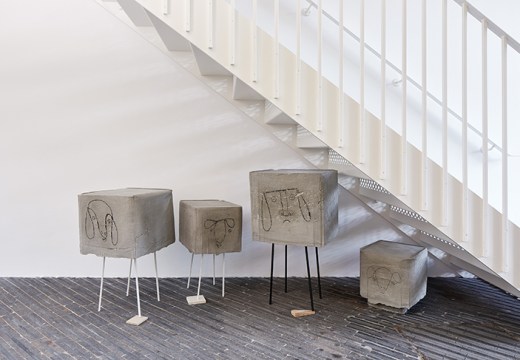
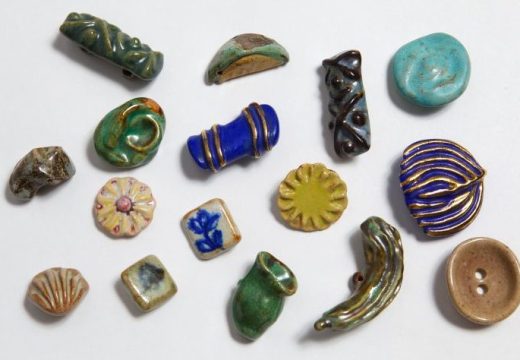









![Masterpiece [Re]discovery 2022. Photo: Ben Fisher Photography, courtesy of Masterpiece London](http://www.apollo-magazine.com/wp-content/uploads/2022/07/MPL2022_4263.jpg)
It’s time for the government of London to return to its rightful home